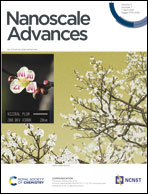Investigating the remediation potential of iron oxide nanoparticles in Cu-polluted soil–plant systems: coupled geochemical, geophysical and biological approaches†
Abstract
Although the use of iron oxide nanoparticles (IONPs) has high potential in remediation and agriculture, a major hindrance to their use includes the risk of contamination of soil and water resources with underexplored effects of IONPs on biota. The fate, phytotoxicity and remediation potential of IONPs are investigated with soil column experiments using 7 nm-sized magnetite (Fe3O4) nanoparticles (magnNPs) and sunflower (Helianthus annuus). Control soil, magnNP-containing soil (10 g magnNPs per kg soil), copper-polluted soil (500 mg Cu per kg soil) and copper-polluted soil containing magnNPs (10 g magnNPs per kg soil and 500 mg Cu per kg soil) support sunflower growth for 57 and 95 days. In magnNP-exposed plants, the occurrence of magnNPs does not affect the growth of the vegetative aerial parts and photosynthetic efficiency. Decreased lipid peroxidation indicates an enhanced antioxidant enzymatic response of magnNP-exposed plants. In plants grown in Cu- and magnNP–Cu-soils, the physiological and biochemical impacts of excess copper are clearly identified, resulting in growth retardation, decreased pigment contents and photosynthetic efficiency, and increased lipid peroxidation and peroxidase (POD) activities. Based on magnetic susceptibility, a higher amount of magnNPs is detected after 57 days in the roots of magnNP-exposed plants (1400 mg kg−1) than in the roots of magnNP–Cu-exposed plants (920 mg kg−1). In the latter, magnNP internalization is likely hampered because of the plants' physiological responses to Cu toxicity. At the working Cu and magnNP concentrations, magnNPs neither decrease Cu accumulation in the plant tissues nor alleviate the overall growth retardation of sunflowers and certain phytotoxic effects induced by excess Cu. However, this study highlights several positive environmental aspects relative to magnNP use, including the harmless effects of magnNPs on sunflowers (1% magnNPs in soil) and the ability of magnNPs to influence Cu mobility in the soil (which could be even more pronounced at lower Cu concentration).



 Please wait while we load your content...
Please wait while we load your content...